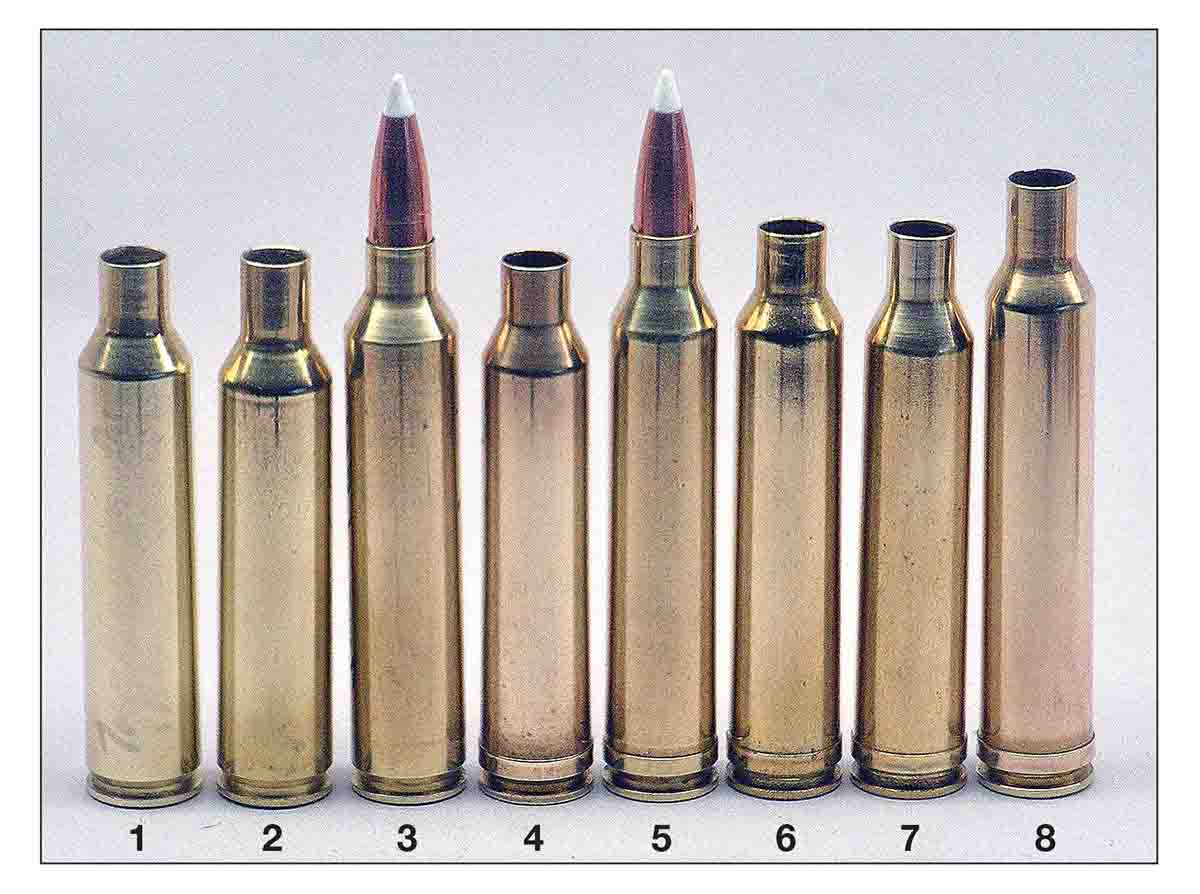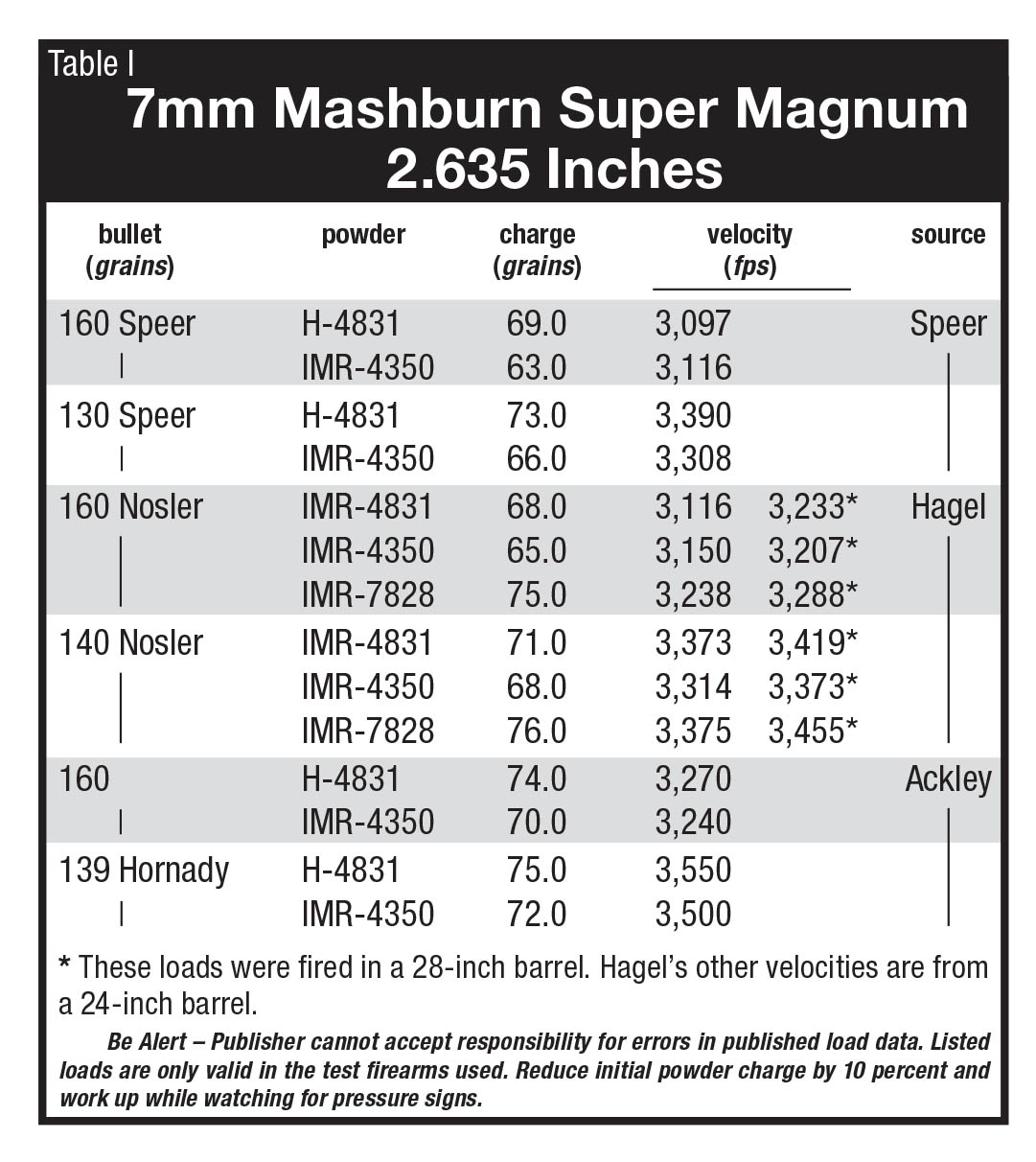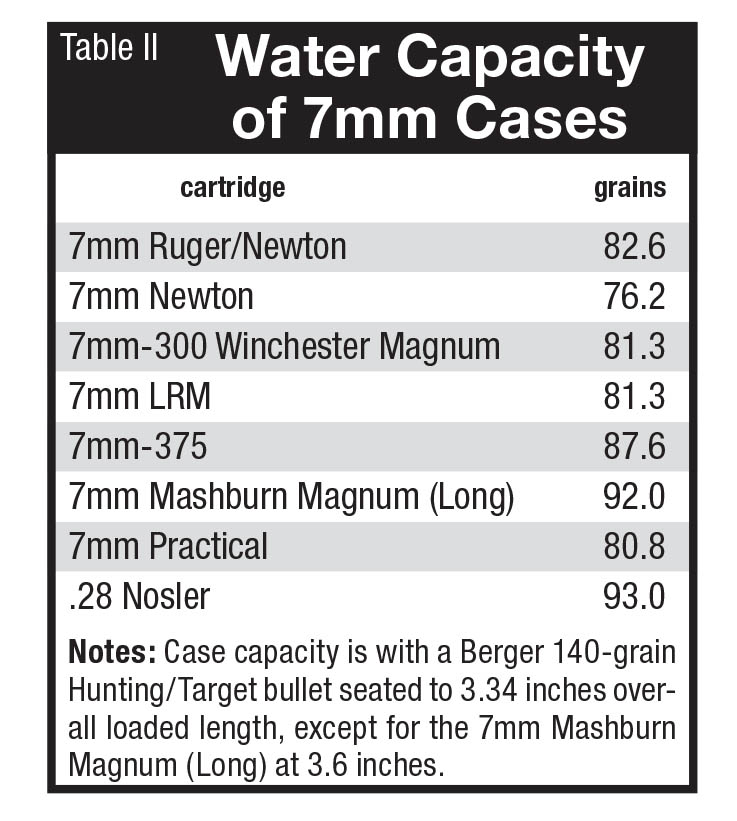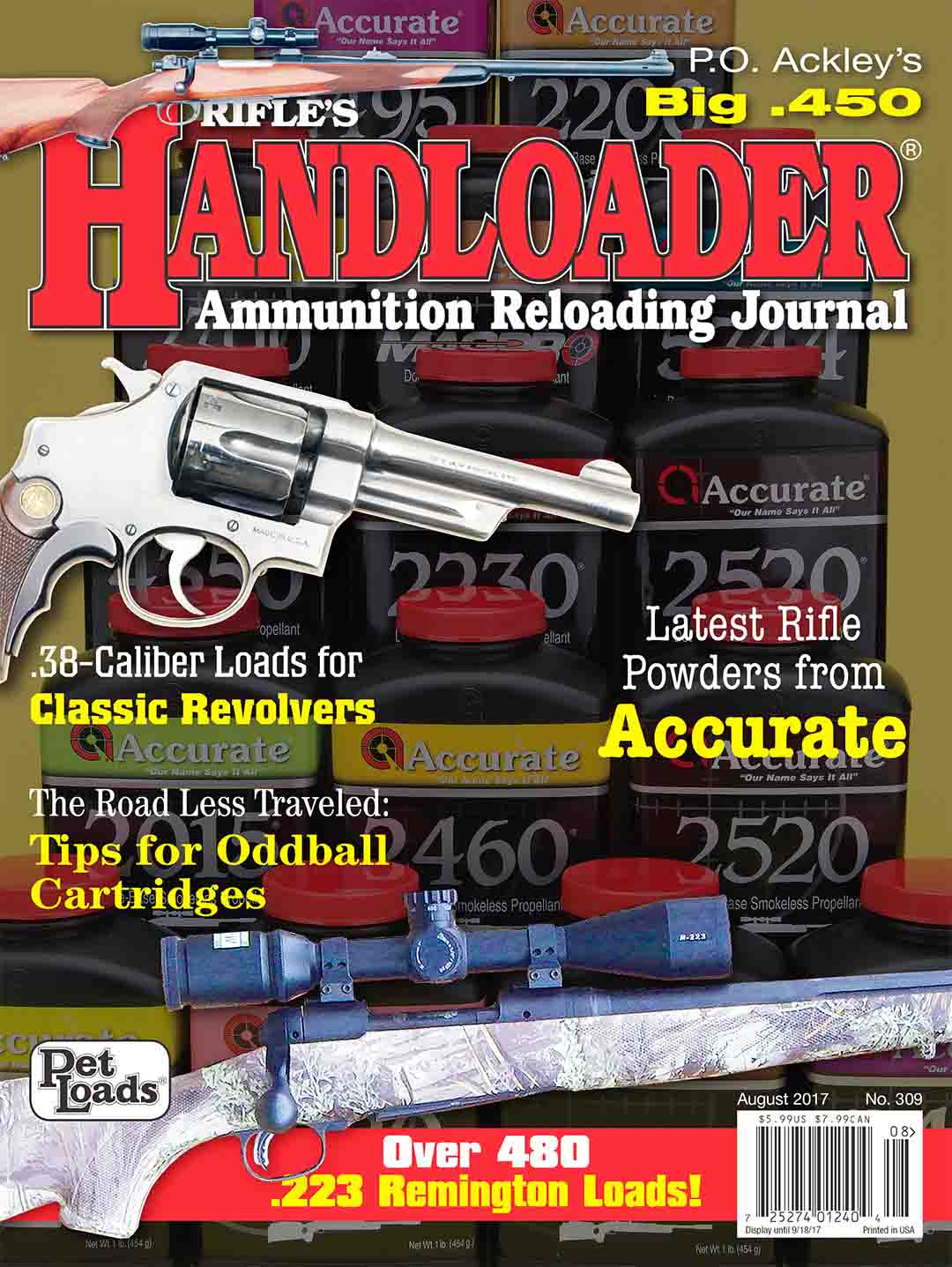Reloader's Press
7MM Wildcats
column By: Dave Scovill | August, 17
There seems to be a fascination with hot-rod 7mm wildcat cartridges lately, most of which are based on the relatively new beltless .28 Nosler or .375 Ruger cases. In large part, however, most of these wildcats have a case capacity within a few grains of a long list of wildcats based on the belted H&H case that dates back to the mid-1900s. P.O. Ackley’s Handbook for Shooters and Reloaders (copyright 1962 and updated in 1965) lists 14, 7mm belted wildcats, a few based on the .30-06 case and several others that are Ackley Improved versions of established standards, like the 7x57mm or .280 Remington, and a few short-fat designs based on the .348 WCF that duplicate the more modern WSM and RSAUM designs based on shortened versions of the .404 Jeffery case.

More recently, there also appears to be a resurgence of interest in the .300 Winchester Magnum that is a bit longer than the standard short magnums at 2.625 inches with a generous powder capacity.
One of the most well-known wildcatters prior to the 1960s was Art Mashburn, with his 7mm Mashburn (short), 7mm Mashburn Super Magnum and a 7mm Mashburn Magnum (long), the latter of which was based on the full-length .300 H&H or .300 Weatherby cases, while the middle version closely resembles the .300 Winchester Magnum with a longer neck. The short version was similar to the Ackley, Sharpe & Hart and .285 Luft magnums. All three had 30-degree shoulder angles, apparently to help form a longer neck length than a 7mm-300 Winchester Magnum might offer with a 25-degree shoulder, unless the shoulder is bumped back .010 inch or so, which is standard for most factory belted magnums, with the exception of the Weatherbys.
The Super Mashburn was a favorite of Warren Page, shooting editor for Field & Stream. Mike Walker at Remington did pressure tests for Page, who passed some of that information on to the late Rifle and Handloader staffer, Bob Hagel. Eventually Hagel wrote an article featuring the Mashburn Super Magum in Rifle No. 103 (January-February 1986). Both of Hagel’s rifles, a Ruger No. 1 with a 28-inch barrel and an FN Mauser with a 24-inch barrel, were chambered to accommodate a Nosler 175-grain Partition seated with its base at the base of the case neck.
Load data for the Super Mashburn in a 2.635-inch case and the similar Luft Magnum (2.440-inch case) was also written up in Speer Wildcat Rifle Loads (volume 2) printed in 1956. Loads for the 7mm Weatherby Magnum were also included in the Speer book, since it was considered a wildcat at the time, along with the other Weatherby cartridges.
Using Speer’s data, the Luft Magnum generated 3,051 fps with 67 grains of H-4831 under a 160- grain bullet, the Mashburn pushed the same bullet 3,007 fps with 69 grains of the same powder, both with 24-inch barrels, while the Weatherby reached 3,198 fps with 72 grains in a freebored 26-inch barrel.
Speer did not have a pressure barrel for these cartridges, and the only statement regarding pressure was “.001 inch belt expansion is excessive,” which suggests Ray Speer might have considered .0004 to .0005 inch belt expansion “acceptable” for a previously unfired case.
The nearby table shows the load data for the 7mm Mashburn Super Magnum reported by Speer in 1956, P.O. Ackley in 1965 and Bob Hagel in 1986. The Ackley data results in velocities that all end in “0,” which usually indicates it was not fired in a rifle but are projections worked out on the Powley Computer for Handloaders. (It is unlikely that Ackley spent hours on end working those loads out on a slide rule with LeDuc’s formula.)
Bob Hagel’s loads were fired in the two rifles noted above. The first set of velocities was fired in the 24-inch Douglas barrel and compare favorably to Speer’s loads for 160-grain bullets, albeit with minor differences in powder charges. The second set [marked in the table with asterisks (*)] was fired from his 28-inch Ruger No. 1 barrel. Also note, Hagel’s loads with a Nolser 140-grain Partition generate velocities that are similar to Speer loads with 130-grain bullets, likely the result of the somewhat freebored chamber Hagel used, and Speer likely used a 3.34-inch overall loaded length. Ackley’s apparent projections are higher than either Speer or Hagel data.
Bob Hagel was also astute enough to test loads for the 7mm Remington Magnum and the 7mm Mashburn Super Magnum in the same barrel to compare velocities, remarking that results with the wildcat were less than expected. P.O. Ackley regularly referred to that phenomenon as “over-bore,” suggesting the case held more powder than could be effectively used in a 7mm barrel.
Considering the current number of wildcats of interest that are based on the .375 Ruger, .404 Jeffery and .300 Winchester Magnum, all of which offer a bit more powder capacity than the 7mm Remington Magnum, the introduction of newer powders in the last 25 years or so that fit in between IMR-4831 and the old IMR-5010 and offer a general increase in performance for the 7mm Remington Magnum should also offer a proportional increase for the old 7mm Super Mashburn. That is not to ignore the crop of longer, sleeker and tougher bullets that have appeared over the last 15 years or so that are designed for magnum velocities, as opposed to the standard cup-and-core 7x57mm Mauser bullets of the 1950s and 1960s, which were probably the reason Page and Hagel insisted on using Nosler Partitions in the belted 7mm’s.

The LRM appears to be designed to fit in a standard .30-06 length action with a 3.34-inch overall loaded length. From photos on the Internet, it looks to be a dead ringer for the 100-year-old 7mm Newton, save for shoulder diameter – .515 inch for the LRM and .500 inch for the Newton.
The 7mm Rogue with a 30-degree shoulder has a longer neck than either the 7mm Remington Magnum or STW. Hornady offers Rogue and LRM dies.
The 7mm Practical resembles the 7x66 Randle and/or 7mm Mashburn Super Magnum. Whether the cartridge is “Practical” or not remains to be seen, since it calls for a 30-degree shoulder and requires a custom chamber reamer, as opposed to simply running a standard 7mm STW reamer into a 7mm Remington chamber far enough to move the shoulder back to fit the necked-down .300 case.
I also dug up yet another variation on the .300 Winchester Magnum that is offered by Redding, simply labeled the 7mm-300 Winchester Magnum that retains the same shoulder angle and length to the shoulder as the parent case. This design results in what some folks might suggest is a too-short neck length of approximately .255 inch, which falls a bit short of bullet diameter. Then, too, none of the Remington or Winchester short magnums have full-caliber length necks; the .338 Winchester Magnum is close with a .330-inch neck length.
The too-short neck controversy came up in 1958 when the .300 Winchester Magnum was introduced and persisted for decades, but that cartridge has gone on to become a standard for hunting big game, long-range target work and military sniper use. So that’s the end of that bag of sour grapes.

There was also a good supply of original Western 2.5-inch .30 Newton brass (circa 1955) on hand with the same base diameter (.532 inch) as the Ruger case and tapered to .500 inch at the shoulder. As it turned out, the .375 Ruger neck sized to 7mm, using .338 RCM, .300 RCM and 7mm WSM sizing dies, in that order, with the same base-to-shoulder length as the .30 Newton with a .515-inch shoulder diameter was quite close to what I was after. From Table II, the case capacity in water of the LRM, 7mm-300 Winchester Magnum, 7mm Ruger/Newton and 7mm Practical are within 1.3 to 1.8 grains but could vary depending on the brand of brass.
I acquired a set of .300 Mashburn Super Magnum loading dies as well and formed a .300 Weatherby case with a long neck to the Mashburn shoulder, then necked it down in a 7mm Remington Magnum full-length sizing die. It sort of split the difference between a 7mm Remington Magnum and STW.
The rationale for the longer case neck on earlier wildcats was to ensure adequate bullet pull, particularly on longer and heavier 160- to 175-grain designs. Some of those rifles were chambered in magnum length actions, such as Bob Hagel’s rifles, and allowed seating the bullets out to accommodate a full complement of powder. That concept works, but only if the barrel is lengthened somewhat to maintain an adequate ex-
pansion ratio, which is a technical term for maximizing the amount of work done by the powder charge. In other words, assuming a given barrel length, seating the bullet out to accommodate a larger powder charge has the net effect of reducing the expansion ratio, doing less work. The cure, as it were, is to increase the barrel length a couple of inches or more, as Bob Hagel did with the 28-inch tube on his Ruger No. 1.
Of course, one of the problems created by seating the bullet out and lengthening the magazine, if required, and the chamber leade, as Hagel did for the Nosler 175-grain Partition, is that all the lighter and shorter bullets have a longer jump to reach the rifling, as in “freebore.” Some feel this prevents any chance of achieving fine accuracy. That may or may not be true but is generally the result of days gone by when leade diameter in front of the case mouth was a bit generous.
From a “practical” point of view, a 7mm Ruger/Newton reamer will clean out a 7mm Remington Magnum chamber and eliminate the “useless” belt, if you want to call it that, while adding a bit more power without an excessive increase in recoil and muzzle blast. It is also relatively painless to run a 7mm STW reamer into a 7mm Remington Magnum chamber to accommodate whatever configuration – from the Super Mashburn to the 7mm-300 Weatherby. With either option, however, some folks may prefer longer or shorter necks, a longer barrel or a different shoulder angle than the industry standard of 25 degrees.
Owing Bob Hagel’s remarks when the Super Mashburn was fired in the original 24-inch 7mm Remington Magnum barrel, however, it probably pays to start from scratch with a 26-inch barrel. In the interest of maintaining sonic velocities at 1,000 yards with a 180-grain bullet, I’m told the LRM has been tested in a 30-inch barrel, reaching roughly 3,200 fps muzzle velocity. In any event, it pays to keep in mind that all modern 7mm bullet designs since 1962 fit ogive shape and length requirements for a 7mm Remington Magnum chambered in a .30-06 length action . . . and still do, including the Berger 195-grain 7mm Elite Hunter.


